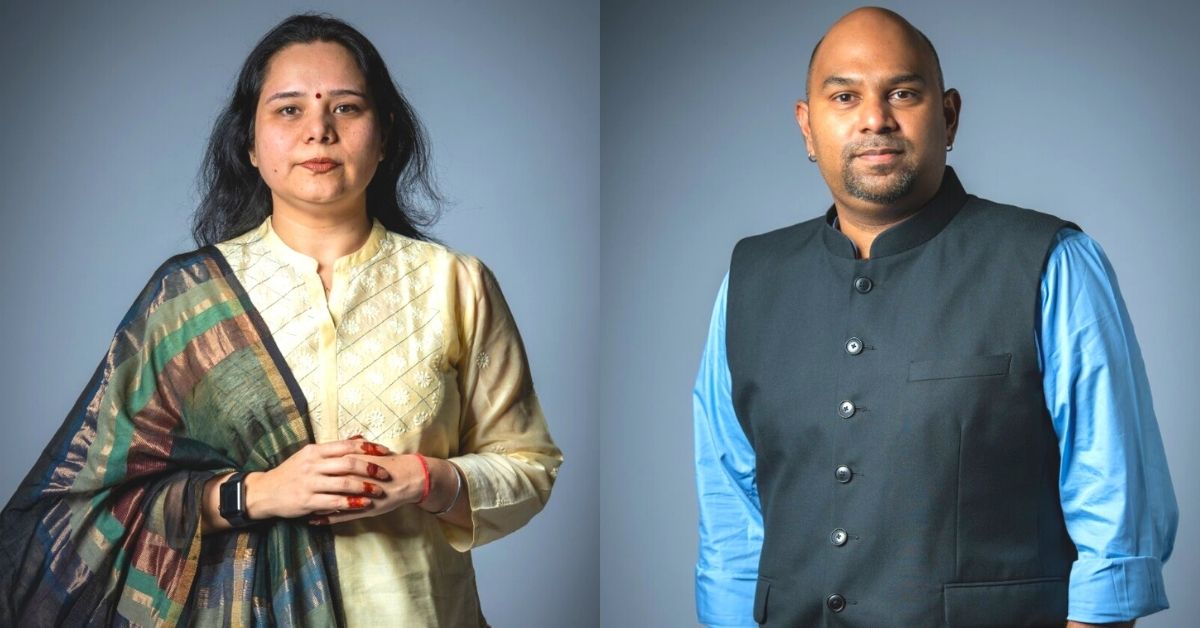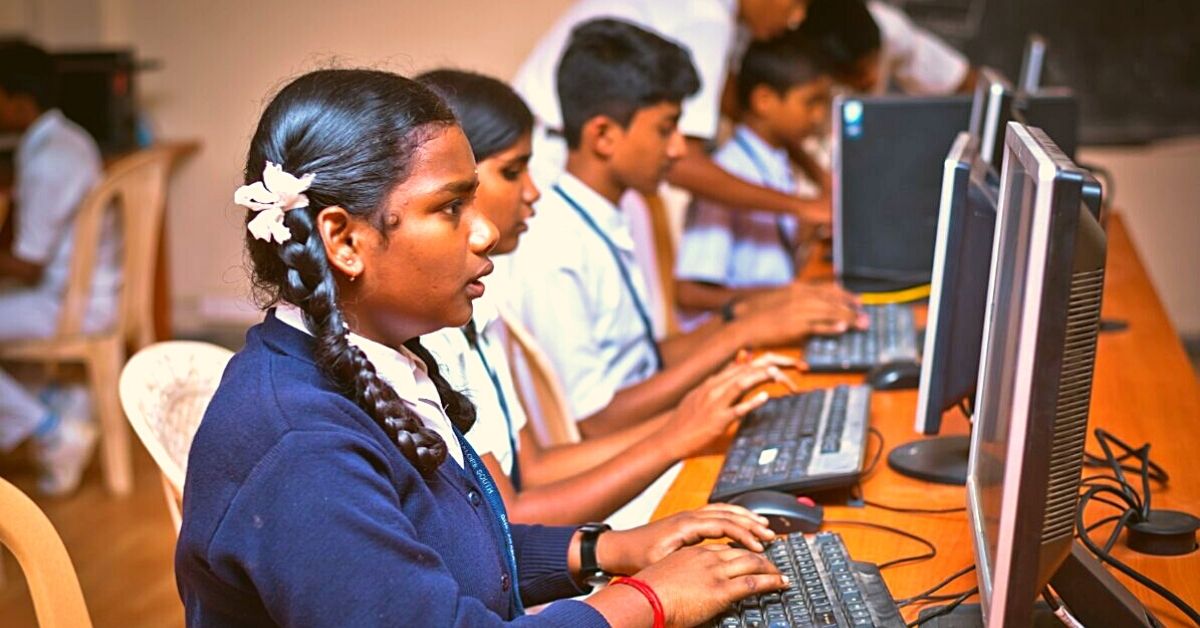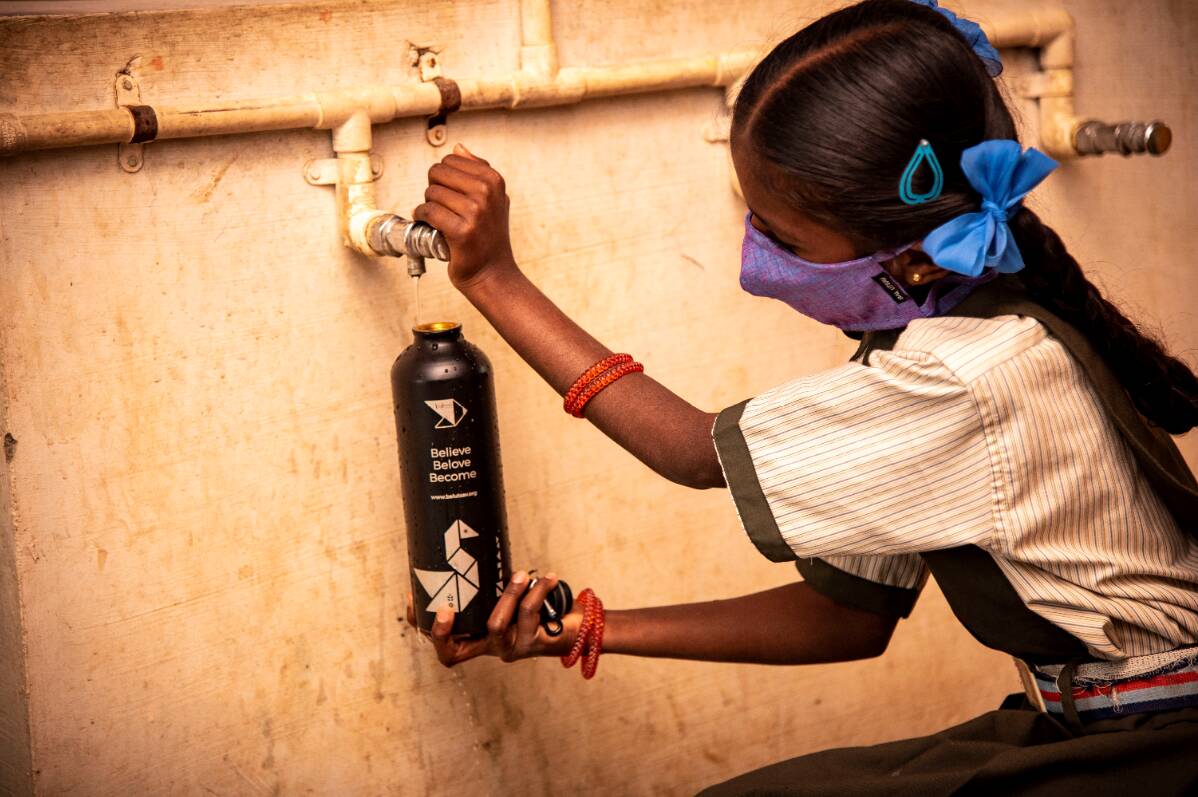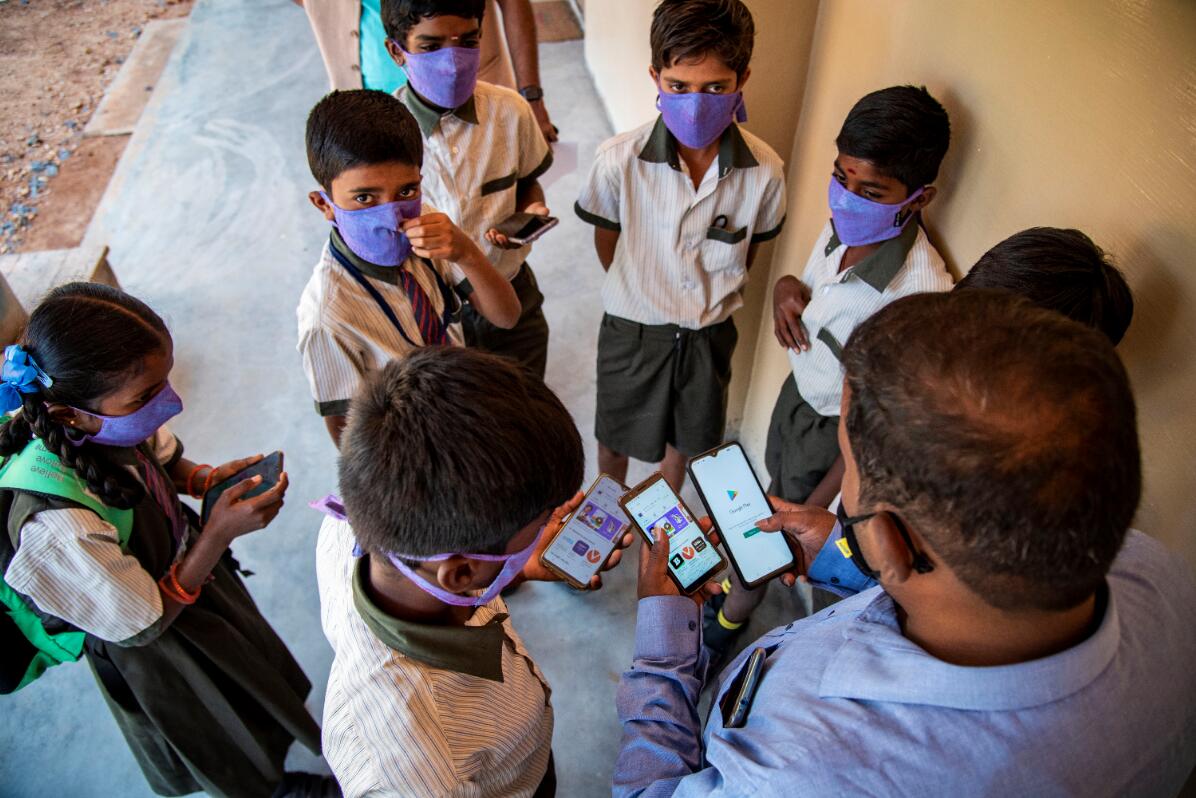8 Lakh Students in Over 200 Govt Schools Are Grateful To This Inspiring Couple
Binu Verma and Ramesh Balasundaram founded Bal Utsav, a non-profit working towards transforming Karnataka's government schools, in 2009.

What happens when two kindred spirits meet and realise that their lives have a greater purpose than a conventional and comfortable corporate job? (Image above of Binu Verma and Ramesh Balasundaram who have changed the lives of nearly 800,000 students in government schools across Karnataka)
They begin by finding that purpose.
In the late 2000s, Binu Verma and Ramesh Balasundaram were courting each other for marriage and also growing tired of the dreariness associated with working as corporate trainers in Bengaluru.
Instead of dedicating their lives to training young Indians to join the corporate workforce, the couple felt that their energies would be better spent addressing the inequities of the public education system.
After all, Binu’s parents and extended family ran schools in Delhi, while Ramesh’s grandparents worked as school teachers and principals in the past. As the couple began the process of quitting their jobs, they were researching the public education system, especially in Karnataka, and the role each sector—private, nonprofit and government—played in addressing its myriad of problems. They soon found a report which would change their lives.

In 2009, the Central Statistical Institute of India reported that there were 3.3 million NGOs registered or one NGO for every 400 Indian citizens. Reading this, they weren’t sure what they could bring to the table. However, they also found that NGOs, governments and the private sector were almost trying to solve the same issues, often competing with each other or working at cross-purposes. Any long-lasting change required each of these sectors to complement each other and take on board various stakeholders.
After carefully studying the public school education space in India, the couple decided to set up an NGO called Bal Utsav in 2009. Incidentally, the couple got married the same year. Their mission was to empower children of the country and provide a better future for them.
They began small by developing the concept of a ‘museum school’, which was essentially a ‘bridge school’ inside well-known museums in Bengaluru for children from low-income households who had dropped out of government schools. Children were taught to read, learn key concepts in subjects, including mathematics and basic sciences.
They were even picked up from their homes and dropped back while receiving free meals. It was a multi-grade learning model for children from urban slums, helping them learn and get into an age-appropriate class in two years from the time they joined.
After incorporating Bal Utsav in 2011, the couple launched ‘The Museum School’ at the Visvesvaraya Industrial and Technological Museum (VITM) on Kasturba Road. ‘Out of School’ children from urban slums were taught here with museum exhibits employed as subjects of study. Despite initial success, Binu and Ramesh felt a larger overhaul of the public education system in Karnataka was needed. After all, some fundamental concerns were starting to emerge in these government schools with regards to quality of teaching, basic infrastructure and opportunities afforded to students there once they reach high school and beyond. Also, more than 60% of the state’s children studied in government schools.
In 2012, Bal Utsav began the process of adopting government schools to bring about what they call ‘holistic reformation’ and developed a 360-degree school revitalisation program. Since the inception of this program, Bal Utsav has revitalised more than 200 government schools in Karnataka, while a variety of their flagship programs have benefited nearly 800,000 students. They go on to claim that their work has led to an increase in government school enrolment, reverse migration from private schools and a reduction in dropouts.

Revamping Public School System in Karnataka
“Through our flagship programs of Sampoorna Shaala and iShaala, we are implementing our 360-degree school revitalisation programme, addressing four key components—school infrastructure, WaSH (water, sanitation and hygiene), teacher development and scholarships for students. We are establishing and operating ‘Model Schools’ for children and their families, where they are given the best resources, and thus making available opportunities to realise their full potential. Most schools and NGOs were used to one-dimensional interventions, whereas we were focused on multiple interventions,” says Binu, speaking to The Better India.
Sampoorna Shaala is a model school designed for large schools with over 500 children, which is “innovative, inclusive, interactive, internet-powered and inspires communities”. iShaala is a model school designed for small schools with under 100 children, which also imparts the same qualities as their larger counterparts. While Sampoorna Shaala aims at the revitalisation of large and urban institutional models, iShaala relies more on technology to rejuvenate the smaller schools with an average strength of 40 students.
Sampoorna Shala was launched in 2015 with four government schools in the Bengaluru area. After incorporating all their learnings from Sampoorna Shala and narrowing down on the specifics for smaller institutions in rural areas, iShaala was formally launched in April 2019. One of the schools they adopted was the government school in Kallahalli village in Bhadravathi Taluk, Shivamogga district.
“Bal Utsav and their CSR partner DXC technology have performed yeoman service to this community by adopting this school. This partnership is a testimony to the cause of delivering quality education and bringing about a change in the lives of our children. Our school, an iShaala, is an example of what an ideal rural school should be. Many schools in India need this kind of support, and my wish is to see all these schools changing as our school has. The transformation of our government school has been done in a manner that nurtures our language and culture,” says Sri Shekharappa Gowda, village head.

Process of Adopting a School
Ramesh lays down the process by which the school is adopted. “We first secure the funding for the schools and then look for schools in need in that specific geography. Our MoU with the Government is at the State or District Level and we thus have enough elbow room to choose the schools that are (the most) in need and not necessarily be influenced by local intervention. Meanwhile, some schools do approach us for adoption and only after due consideration, including if they can form a cluster of schools, and are a combination of schools that feed into each other, we spell out the intent for adoption. We prefer to take co-educational schools, followed by gender-based ones. The School Principal along with the SDMC (School Development and Monitoring Committee) then give us a formal request for adoption along with consent to sign up for the performance-based outcome model.”
After assessing the school’s needs, Bal Utsav prepares a ‘School Development Plan’, a broad roadmap for three to five years for the school. To execute this plan, a budget is prepared and mapped to committed resources. This is followed by ongoing interventions at the Selected Schools and from the second year onwards scholarships are rolled out.
“At the end of the funding cycle, we revert to the donor and offer them a right of first refusal to continue to support the school. The following interventions lead to an increase in enrolment, decrease in attrition and better learning outcomes, while also increasing the perceived value of the school in a variety of ways,” says Ramesh.

So, what are these interventions?
Schools without adequate or crumbling hard infrastructure—dilapidated classrooms, toilets, or compound walls, among others—or soft infrastructure like lights, fans, notebooks, etc, suggest apathy, lack of imagination and structural flaws in how they’re managed.
“Our focussed interventions make a difference in making available resources that effectively help the children learn and stay in school. For example, at the Government Primary School in Immadihalli in Whitefield, Bal Utsav has organised painting and repairs of the entire school, installed new lights and fans, a first aid kit with refills provided annually and a rainwater harvesting solution. Meanwhile, at the Government Upper Primary School in Vajarahalli in the Tumkur area, they have installed an e-classroom. In another school, we have provided tablets and installed a WiFi mesh to ensure learning can happen anywhere in school while staying connected to high-quality content and delivered school kits comprising school bags, water bottles, notebooks, shoes, examination pads, etc,” explains Ramesh.
Bal Utsav also runs a successful Menstrual Hygiene Program for girls in all their schools, providing free menstrual hygiene supplies and menstrual waste disposal IOT-enabled mechanisms, coupled with awareness sessions to enable girls to attend school 365 days a year. “We appoint janitors and equip them with washroom cleaning supplies to maintain clean, hygienic toilets,” adds Binu.
“To ensure students are learning effectively, we are changing the way teacher development programs are facilitated through workshops, and personalised coaching. We equip teachers with innovative, interactive methodologies and age-appropriate, dynamic materials to enhance teaching of the national curriculum. Through this we ensure students are receiving a high-quality education, and we provide teachers with necessary training and innovative resources, thus enhancing the delivery of the curriculum and empowering them to lead dynamic and effective lessons. We make available Para Teachers where required to fill the gap of acute teacher shortage, thereby making amends to the skewed student-teacher ratio and enabling teachers to deliver better at the supported schools,” says Ramesh.

Eligible students from our Sampoorna Shaala and iShaala programs are taken through a carefully planned process of selection and the top 1 to 3% are finally selected.
These are fully funded scholarships that take care of elements like fees, books, uniforms, etc. and are paid for all students who continue to demonstrate commitment and combine it with academic excellence leading to employment.
“We currently have over a 100 students who are beneficiaries of our scholarship program. The scholarship program is designed for the top 1% (academics) of students from our Sampoorna Shaala and iShaala programs. In very limited cases we do extend this scholarship to specific individuals who suffer a physical disability or need support after the loss of life of a family member, among other extenuating circumstances. The average investment we make per child per year is approximately Rs 1,50,000,” says Binu.
While Bal Utsav commits to a minimum of 5% increase in enrolment at each of their schools, they have seen instances when there is an increase of over 20% in an academic year. For example, the Government Higher Primary School in Nidige, Shimoga District, is one of the schools under their iShaala programme that has demonstrated a 20% increase in enrolment.
“Most children who come to our school are from farming communities. The government mandates a school within a kilometre radius. However, some of our school children come from a distance of more than 2 kms. Summer, winter or rain, our children walk across fields and through narrow pathways to reach the school every day. The motivation for them to do this is the high quality of the facilities that they receive here,” says V. Hiremath, Headmaster of the Government Higher Primary School in Kallahalli village.
Results from these programs start showing in the first year itself, although for total transformation, it usually takes about three years, claims Ramesh.
However, none of these programs take off without the requisite funding. Their current sources of funding include individuals, organisations, CSR, donations from Indians settled abroad (FCRA), support from private foundations and also from participation in events, etc.
“We are supported by over 60 corporates, many of whom channelise their CSR funds through us. We haven’t finalised our books of accounts for the last year, but the provisional data reflects approximately Rs 5 Crores during what was a COVID year,” says Binu.

Tackling COVID
With schools largely closed down during the pandemic, students had to resort to online learning. This transition was made easier for students attending Bal Utsav-supported schools because of prior emphasis on online modes of learning.
“There is no denying that the effectiveness of learning can be supplemented through digital interventions. The challenge, however, is when people start believing that online learning is an alternative to going to school. It’s obviously not. The ideal way is to adopt a blended learning mechanism during extraordinary circumstances like these so that children continue learning either from their homes on personal or shared devices. We should supplement existing initiatives of the government and make available more Digital Content (Device Agnostic) in various languages for children to consume and couple that with learning analysis based on how children are using them,” says Binu.
However, Bal Utsav has gone beyond facilitating online learning. Since the first lockdown last year, through their Dayvita program, they have distributed 24,000 tonnes of food and other supplies to over 30,000 families. Since 2020, the team claims to have distributed over 78,000 food and hygiene kits each, more than 30,000 litres of water, 1.4 crore meals, over 11 lakh sanitary pads, 1 lakh ORS packets in Karnataka and adjoining areas—procuring them with the help of donations, both in terms of cash and material aid.
The immediate road ahead is to alleviate the financial and resource crunch suffered by families of these students, particularly in rural Karnataka. However, the long term goal is to adopt more government schools beyond Karnataka.
(Edited by Yoshita Rao)
Like this story? Or have something to share? Write to us: [email protected], or connect with us on Facebook and Twitter.
If you found our stories insightful, informative, or even just enjoyable, we invite you to consider making a voluntary payment to support the work we do at The Better India. Your contribution helps us continue producing quality content that educates, inspires, and drives positive change.
Choose one of the payment options below for your contribution-
By paying for the stories you value, you directly contribute to sustaining our efforts focused on making a difference in the world. Together, let’s ensure that impactful stories continue to be told and shared, enriching lives and communities alike.
Thank you for your support. Here are some frequently asked questions you might find helpful to know why you are contributing?


This story made me
-
97
-
121
-
89
-
167











